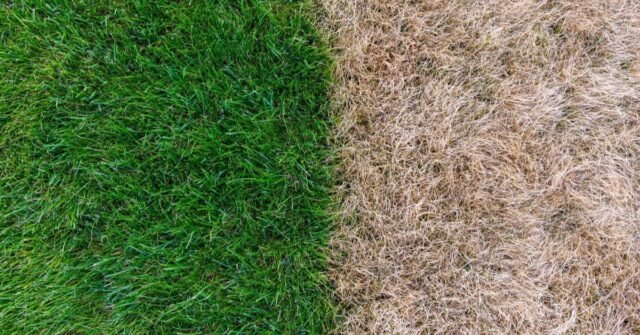During dry weather, lawn care becomes more delicate and mistakes can quickly cause long-term harm. Many homeowners unknowingly damage their lawns by using incorrect watering schedules, trimming too short, or using tools improperly. Especially in a dry climate, lawns need careful attention to avoid stress on the grass and soil. Missteps like walking on brittle turf or applying chemicals during heat spells can quickly turn a healthy lawn into a patchy mess. At texas landscape, we help homeowners recognize and fix these issues before the damage spreads. This article will explain common lawn care errors and how they impact dry-weather lawns. Whether you’re maintaining your home yard or managing a larger property, understanding proper care techniques can protect and enhance your landscape texas lawn effectively.
Overwatering on Hot Days Leads to Root Rot
Overwatering may seem helpful in dry weather, but it actually damages grass roots when done during peak heat. When lawns receive too much water, especially in full sun, the soil becomes waterlogged, and oxygen levels drop. This causes root rot, weakening the lawn’s ability to absorb nutrients. Grass blades may turn yellow or wilt despite excess moisture. At texas landscape, we recommend watering early in the morning when evaporation is low and roots can absorb moisture slowly. Overwatering at the wrong time in a landscape texas setting results in fungal growth and shallow roots. These lawns often become more dependent on frequent watering and less tolerant to heat or drought. By adjusting watering habits to match the region’s dry conditions, property owners can keep their lawns healthier and avoid irreversible damage caused by rot.
Cutting Grass Too Short Exposes Soil to Sun
When grass is cut too short during hot weather, it removes the protective shade that the blades provide to the soil underneath. This exposes the soil to direct sunlight, causing it to dry out faster and become compacted. As the soil hardens, roots can’t grow deeply, and the lawn struggles to retain moisture. This error often results in a dull, stressed look and brown patches. texas landscape recommends leaving grass slightly taller during dry seasons to maintain soil cover and keep grass healthier. In any landscape texas environment, preserving soil moisture is critical. Taller blades naturally shade the ground, reduce evaporation, and help resist weed growth. Avoiding close mowing allows your grass to survive heat stress more easily and bounce back after dry spells. Proper mowing height is a simple yet powerful technique to support lawn health.
Fertilizing in Drought Burns Grass Blades
Fertilizing during a drought might seem like a way to boost growth, but it actually causes more harm than good. Dry lawns can’t properly absorb nutrients, especially when the soil lacks moisture. Applying fertilizer in these conditions often burns grass blades, leading to yellowing or browning. This kind of damage weakens the entire turf and makes it harder to recover after dry weather. At texas landscape, we advise homeowners to avoid fertilizing until the lawn is well-hydrated. For landscape texas areas, the timing of lawn treatments is crucial to prevent unnecessary stress. Instead of improving lawn color or growth, fertilizer in a drought often triggers chemical reactions that dry out already stressed plants. Waiting until the soil is moist ensures the nutrients are used efficiently and the lawn remains vibrant and strong.
Watering at the Wrong Time Wastes Moisture
Watering a lawn at the wrong time of day can be one of the most wasteful mistakes, especially during dry periods. Midday watering under the hot sun causes quick evaporation before water reaches the roots. This not only wastes water but also leaves the lawn thirsty and stressed. Morning watering is ideal because it gives water time to soak into the soil before heat rises. At texas landscape, we guide customers in designing irrigation plans that suit their schedule and climate. When working in landscape texas zones, correct watering timing makes all the difference. Watering in the evening can also cause moisture to sit overnight, encouraging fungal growth. Following the right timing reduces water waste, helps roots grow deeper, and protects your lawn’s appearance and long-term health in a dry season.
Dull Mower Blades Tear Grass Instead of Cutting
Using dull mower blades damages grass by tearing it instead of cutting cleanly. Torn grass blades are more vulnerable to moisture loss and can develop brown tips that make the lawn look neglected. In dry weather, these open wounds leave grass susceptible to diseases and heat damage. Regularly sharpening mower blades ensures a clean cut that heals quickly. At texas landscape, we encourage routine tool maintenance as a key part of lawn care. In the heat of a landscape texas summer, even minor errors can become major problems. A torn blade also means the plant has to use more energy to repair itself, weakening root development and overall resilience. Simple maintenance of cutting tools can significantly improve lawn health and appearance throughout the hot season.
Walking on Dry Grass Damages the Roots
When the lawn is dry and brittle, walking across it can compress the soil and break the grass blades. Each step pushes down on the fragile turf, damaging roots and making it harder for the lawn to bounce back. Especially in high-traffic areas, foot pressure leads to thinning patches and lasting soil compaction. At texas landscape, we often recommend temporary walkways or reduced movement during dry periods to avoid this damage. In landscape texas conditions, where dryness can persist for weeks, even minimal stress can add up quickly. Preventing foot traffic helps protect soil structure and keeps oxygen and water pathways open for healthy root growth. Respecting the lawn’s delicate state during drought ensures quicker recovery and longer-lasting results throughout the season.
Using Herbicides During Heat Stresses the Lawn
Applying herbicides during hot, dry weather can put too much stress on your lawn. While these chemicals target weeds, they can also affect the grass itself, especially when it’s already weakened by heat. The grass may turn brown, become brittle, or even die back in patches. At texas landscape, we recommend avoiding herbicide treatments until temperatures are moderate and soil moisture is adequate. In any landscape texas environment, careful scheduling of weed control treatments is essential. Heat combined with chemicals increases the chance of burning the grass and disrupting natural growth patterns. Weeds may also become more resistant if treated ineffectively under harsh conditions. Waiting for the right weather reduces risks and leads to more successful weed control without harming the overall lawn health.
Ignoring Brown Spots Allows Lawn Damage to Spread
Brown spots on the lawn are early warnings of stress, disease, or improper watering. Ignoring these signs allows the damage to spread across the turf, making recovery more difficult. These spots might indicate compacted soil, fungal issues, or pet activity. In dry weather, the cause often relates to inconsistent moisture or sunburned patches. At texas landscape, we help clients identify and treat these areas quickly to prevent further deterioration. For a healthy landscape texas lawn, early action is vital. Brown spots that are left untreated may expand, leading to large bare areas that require reseeding. Monitoring your lawn weekly and responding to problem areas with proper watering, mowing, or soil adjustments helps prevent long-term issues and supports a greener, more consistent lawn year-round.
Removing Grass Clippings Reduces Natural Moisture Cover
Grass clippings act as a natural mulch when left on the lawn, helping retain moisture and protect the soil from heat. Removing them during dry conditions exposes the soil and increases evaporation. This makes the lawn dry out faster and reduces organic matter that could improve soil health. At texas landscape, we suggest mulching with clippings whenever possible. In landscape texas areas, moisture preservation is essential to survive prolonged heat. Leaving clippings behind also reduces the need for extra fertilizers since they return nutrients to the soil. While it may seem cleaner to collect them, keeping clippings helps lawns stay green, cool, and protected in tough weather. This simple practice adds a valuable layer of insulation that benefits both the turf and soil structure.
Watering Too Often Weakens Root Systems
Watering too frequently may feel helpful, but it actually encourages shallow roots that can’t handle drought well. Shallow roots stay near the surface, where soil dries out quickly, leaving grass vulnerable during heatwaves. Deep watering, done less often, encourages roots to grow downward in search of moisture. At texas landscape, we teach homeowners to adjust watering intervals for stronger turf. In landscape texas conditions, overwatering can be just as harmful as under-watering. A weak root system results in a lawn that wilts easily and recovers slowly after stress. Proper watering techniques make a huge difference in overall resilience and appearance. Training the roots to go deeper gives lawns a solid foundation to survive long stretches of hot, dry days without losing their lush look.
Click here: smartskill97







